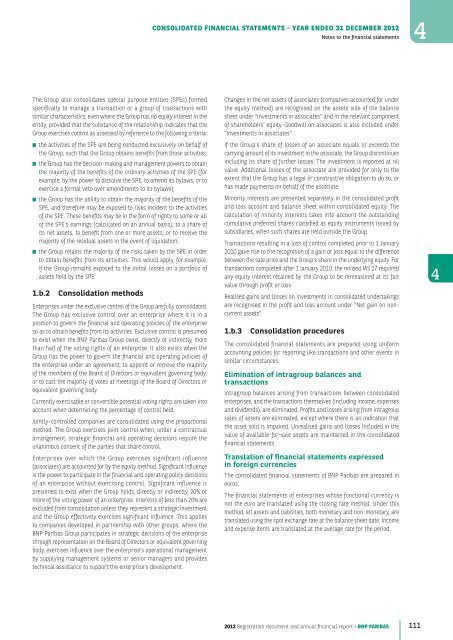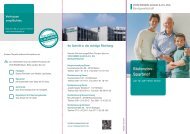2012 Registration document and annual financial report - BNP Paribas
2012 Registration document and annual financial report - BNP Paribas
2012 Registration document and annual financial report - BNP Paribas
- No tags were found...
Create successful ePaper yourself
Turn your PDF publications into a flip-book with our unique Google optimized e-Paper software.
CONSOLIDATED FINANCIAL STATEMENTS - YEAR ENDED 31 DECEMBER <strong>2012</strong>Notes to the <strong>financial</strong> statements4The Group also consolidates special purpose entities (SPEs) formedspecifically to manage a transaction or a group of transactions withsimilar characteristics, even where the Group has no equity interest in theentity, provided that the substance of the relationship indicates that theGroup exercises control as assessed by reference to the following criteria:■ the activities of the SPE are being conducted exclusively on behalf ofthe Group, such that the Group obtains benefits from those activities;■ the Group has the decision-making <strong>and</strong> management powers to obtainthe majority of the benefits of the ordinary activities of the SPE (forexample, by the power to dissolve the SPE, to amend its bylaws, or toexercise a formal veto over amendments to its bylaws);■ the Group has the ability to obtain the majority of the benefits of theSPE, <strong>and</strong> therefore may be exposed to risks incident to the activitiesof the SPE. These benefits may be in the form of rights to some or allof the SPE’s earnings (calculated on an <strong>annual</strong> basis), to a share ofits net assets, to benefit from one or more assets, or to receive themajority of the residual assets in the event of liquidation;■ the Group retains the majority of the risks taken by the SPE in orderto obtain benefits from its activities. This would apply, for example,if the Group remains exposed to the initial losses on a portfolio ofassets held by the SPE.1.b.2Consolidation methodsEnterprises under the exclusive control of the Group are fully consolidated.The Group has exclusive control over an enterprise where it is in aposition to govern the <strong>financial</strong> <strong>and</strong> operating policies of the enterpriseso as to obtain benefits from its activities. Exclusive control is presumedto exist when the <strong>BNP</strong> <strong>Paribas</strong> Group owns, directly or indirectly, morethan half of the voting rights of an enterprise. It also exists when theGroup has the power to govern the <strong>financial</strong> <strong>and</strong> operating policies ofthe enterprise under an agreement; to appoint or remove the majorityof the members of the Board of Directors or equivalent governing body;or to cast the majority of votes at meetings of the Board of Directors orequivalent governing body.Currently exercisable or convertible potential voting rights are taken intoaccount when determining the percentage of control held.Jointly-controlled companies are consolidated using the proportionalmethod. The Group exercises joint control when, under a contractualarrangement, strategic <strong>financial</strong> <strong>and</strong> operating decisions require theunanimous consent of the parties that share control.Enterprises over which the Group exercises significant influence(associates) are accounted for by the equity method. Significant influenceis the power to participate in the <strong>financial</strong> <strong>and</strong> operating policy decisionsof an enterprise without exercising control. Significant influence ispresumed to exist when the Group holds, directly or indirectly, 20% ormore of the voting power of an enterprise. Interests of less than 20% areexcluded from consolidation unless they represent a strategic investment<strong>and</strong> the Group effectively exercises significant influence. This appliesto companies developed in partnership with other groups, where the<strong>BNP</strong> <strong>Paribas</strong> Group participates in strategic decisions of the enterprisethrough representation on the Board of Directors or equivalent governingbody, exercises influence over the enterprise’s operational managementby supplying management systems or senior managers <strong>and</strong> providestechnical assistance to support the enterprise’s development.Changes in the net assets of associates (companies accounted for underthe equity method) are recognised on the assets side of the balancesheet under “Investments in associates” <strong>and</strong> in the relevant componentof shareholders’ equity. Goodwill on associates is also included under“Investments in associates”.If the Group’s share of losses of an associate equals or exceeds thecarrying amount of its investment in the associate, the Group discontinuesincluding its share of further losses. The investment is <strong>report</strong>ed at nilvalue. Additional losses of the associate are provided for only to theextent that the Group has a legal or constructive obligation to do so, orhas made payments on behalf of the associate.Minority interests are presented separately in the consolidated profit<strong>and</strong> loss account <strong>and</strong> balance sheet within consolidated equity. Thecalculation of minority interests takes into account the outst<strong>and</strong>ingcumulative preferred shares classified as equity instruments issued bysubsidiaries, when such shares are held outside the Group.Transactions resulting in a loss of control completed prior to 1 January2010 gave rise to the recognition of a gain or loss equal to the differencebetween the sale price <strong>and</strong> the Group’s share in the underlying equity. Fortransactions completed after 1 January 2010, the revised IAS 27 requiredany equity interest retained by the Group to be remeasured at its fairvalue through profit or loss.Realised gains <strong>and</strong> losses on investments in consolidated undertakingsare recognised in the profit <strong>and</strong> loss account under “Net gain on noncurrentassets”.1.b.3Consolidation proceduresThe consolidated <strong>financial</strong> statements are prepared using uniformaccounting policies for <strong>report</strong>ing like transactions <strong>and</strong> other events insimilar circumstances.Elimination of intragroup balances <strong>and</strong>transactionsIntragroup balances arising from transactions between consolidatedenterprises, <strong>and</strong> the transactions themselves (including income, expenses<strong>and</strong> dividends), are eliminated. Profits <strong>and</strong> losses arising from intragroupsales of assets are eliminated, except where there is an indication thatthe asset sold is impaired. Unrealised gains <strong>and</strong> losses included in thevalue of available-for-sale assets are maintained in the consolidated<strong>financial</strong> statements.Translation of <strong>financial</strong> statements expressedin foreign currenciesThe consolidated <strong>financial</strong> statements of <strong>BNP</strong> <strong>Paribas</strong> are prepared ineuros.The <strong>financial</strong> statements of enterprises whose functional currency isnot the euro are translated using the closing rate method. Under thismethod, all assets <strong>and</strong> liabilities, both monetary <strong>and</strong> non-monetary, aretranslated using the spot exchange rate at the balance sheet date. Income<strong>and</strong> expense items are translated at the average rate for the period.4<strong>2012</strong> <strong>Registration</strong> <strong>document</strong> <strong>and</strong> <strong>annual</strong> <strong>financial</strong> <strong>report</strong> - <strong>BNP</strong> PARIBAS 111





